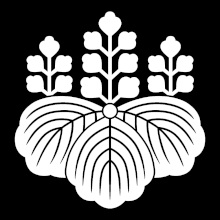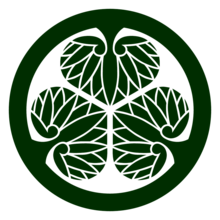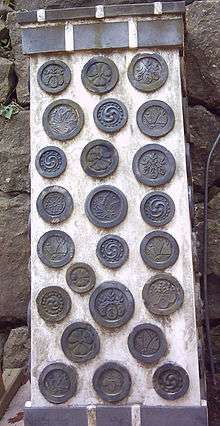Mon (emblem)
Mon (紋), also monshō (紋章), mondokoro (紋所), and kamon (家紋), are Japanese emblems used to decorate and identify an individual, a family, or (more recently) an institution or business entity. While mon is an encompassing term that may refer to any such device, kamon and mondokoro refer specifically to emblems used to identify a family. An authoritative mon reference compiles Japan's 241 general categories of mon based on structural resemblance (a single mon may belong to multiple categories), with 5116 distinct individual mon (it is however well acknowledged that there exist lost or obscure mon that are not in this compilation).[1][2]



The devices are similar to the badges and coats of arms in European heraldic tradition, which likewise are used to identify individuals and families. Mon are often referred to as crests in Western literature, another European heraldic device similar to the mon in function.
History

Mon may have originated as fabric patterns to be used on clothes in order to distinguish individuals or signify membership of a specific clan or organization. By the twelfth century, sources give a clear indication that heraldry had been implemented as a distinguishing feature, especially for use in battle. It is seen on flags, tents, and equipment.
Like European heraldry, mon were initially held only by aristocratic families, and were gradually adapted by commoners. On the battlefield, mon served as army standards, even though this usage was not universal and uniquely designed army standards were just as common as mon-based standards (cf. sashimono, uma-jirushi). Mon were also adapted by various organizations, such as merchant and artisan guilds, temples and shrines, theater troupes and even criminal gangs. In an illiterate society, they served as useful symbols for recognition.
Japanese traditional formal attire generally displays the mon of the wearer. Commoners without mon often used those of their patron or the organization they belonged to. In cases when none of those were available, they sometimes used one of the few mon which were seen as "vulgar", or invented or adapted whatever mon they wished, passing it on to their descendants. It was not uncommon for shops, and therefore shop-owners, to develop mon to identify themselves.
Rules regulating the choice and use of mon were somewhat limited, though the selection of mon was generally determined by social customs. It was considered improper to use a mon that was known to be held by someone else, and offensive to use a mon that was held by someone of a high rank. When mon came into conflict, the lower-ranked person sometimes changed their mon to avoid offending their superior. The mon held by the ruling clans of Japan, such as Tokugawa's hollyhock mon and the Emperor's chrysanthemum mon, were legally protected from unauthorized usage.
Occasionally, patron clans granted the use of their mon to their retainers as a reward. Similar to the granting of the patron's surnames, this was considered a very high honor. Alternatively, the patron clan may have added elements of its mon to that of its retainer, or chosen an entirely different mon for them.
Design
There are no set rules in the design of a mon. Most consist of a roundel encircling a figure of plant, animal, man-made, natural or celestial objects, all abstracted to various degrees. Religious symbols, geometric shapes and kanji were commonly used as well.
Similar to the blazon in European heraldry, mon are also named by the content of the design, even though there is no set rule for such names. Unlike in European heraldry, however, this "blazon" is not prescriptive—the depiction of a mon does not follow the name—instead the names only serve to describe the mon. The pictorial depictions of the mon are not formalized and small variations of what is supposed to be the same mon can sometimes be seen, but the designs are for the most part standardized through time and tradition.
The degree of variation tolerated differ from mon to mon as well. For example, the paulownia crest with 5-7-5 leaves is reserved for the prime minister, whereas paulownia with fewer leaves could be used by anyone. The imperial chrysanthemum also specifies 16 petals, whereas chrysanthemum with fewer petals are used by other lesser imperial family members.
Japanese heraldry does not have a cadency or quartering system, but it is not uncommon for cadet branches of a family to choose a slightly different mon from the senior branch. Each princely family (Shinnōke), for example, uses a modified chrysanthemum crest as their mon. Mon holders may also combine their mon with that of their patron, benefactor or spouse, sometimes creating increasingly complicated designs.
Mon are essentially monochrome; the color does not constitute part of the design and they may be drawn in any color.
Modern usage

Virtually all modern Japanese families have a mon, but unlike before the Meiji Restoration when rigid social divisions existed, mon play a more specialized role in everyday life. On occasions when the use of a mon is required, one can try to look up their families in the temple registries of their ancestral hometown or consult one of the many genealogical publications available. Many websites also offer mon lookup services. Professional wedding planners, undertakers and other "ritual masters" may also offer guidance on finding the proper mon.
Mon are seen widely on stores and shops engaged in traditional crafts and specialties. They are favored by sushi restaurants, which often incorporate a mon into their logos. Mon designs can even be seen on the ceramic roof tiles of older houses. Mon designs frequently decorate senbei, sake, tofu and other packaging for food products to lend them an air of elegance, refinement and tradition. The paulownia mon appears on the obverse side of the 500 yen coin.
Items symbolizing family crafts, arts or professions were often chosen as a mon. A fan design might be chosen by a geisha, though in the present day, geisha typically wear the mon of their okiya (geisha house) on their clothing when working; individual geisha districts, known as hanamachi, also have their own distinctive mon, such as the plover crest (chidori) of Ponto-chō in Kyoto.
A woman may still wear her maiden mon if she wishes and pass it on to her daughters; she does not have to adopt her husband's or father's mon. Flowers, trees, plants and birds are also common elements of mon designs.[3]
Mon also add formality to a kimono. A kimono may have one, three or five mon. The mon themselves can be either formal or informal, depending on the formality of the kimono, with formality ranging from the most formal "full sun" (hinata) crests to the least formal "shadow" (kage) crests. Very formal kimono display more mon, frequently in a manner that makes them more conspicuous; the most formal kimono display mon on both sides of the chest, on the back of each sleeve, and in the middle of the back. On the armor of a warrior, it might be found on the kabuto (helmet), on the do (breast plate), and on flags and various other places. Mon also adorned coffers, tents, fans and other items of importance.
As in the past, modern mon are not regulated by law, with the exception of the Imperial Chrysanthemum, which doubles as the national emblem, and the paulownia, which is the mon of the office of prime minister and also serves as the emblem of the cabinet and government (see national seals of Japan for further information). Some local governments and associations may use a mon as their logo or trademark, thus enjoying its traditional protection, but otherwise mon are not recognized by law. One of the best known examples of a mon serving as a corporate logo is that of Mitsubishi, a name meaning "three lozenges" (occasionally translated as "three buffalo nuts"), which are represented as rhombuses.[4] Another example of corporate use is the logo for the famous soy sauce maker Kikkoman, which uses the family mon of the founder,[5] and finally, the logo of music instrument/equipment and motorcycle builder Yamaha, which shows three tuning forks interlocked into the shape of a capital Y in reference to both their name and the origin of the company.[6]
In Western heraldry
.svg.png)
Japanese mon are sometimes used as charges or crests in Western heraldry. They are blazoned in traditional heraldic style rather than in the Japanese style. Examples include the Canadian-granted arms of David Tsubouchi[7], and Akihito's arms as a Knight of the Garter.[8]
References
- 日本の家紋大全 梧桐書院 ISBN 434003102X
- Some 6939 mon are listed here Archived 2016-10-28 at the Wayback Machine.
- Nakano, Mas. "Family Crests - Mon". Japan-Society.org. Japan Society of San Diego and Tijuana. Retrieved 4 June 2013.
- "The Mitsubishi Mark". Mitsubishi.com. 2008. Accessed 10 August 2008.
- "My family's kamon and history". Archived from the original on 2012-12-14. Retrieved 2010-09-04.
- Yamaha's logo
- Tsubouchi, David Hiroshi, Public Register of Arms, Flags and Badges of Canada
- Coat of arms of Heisi Tenno, numericana
External links
| Wikimedia Commons has media related to |